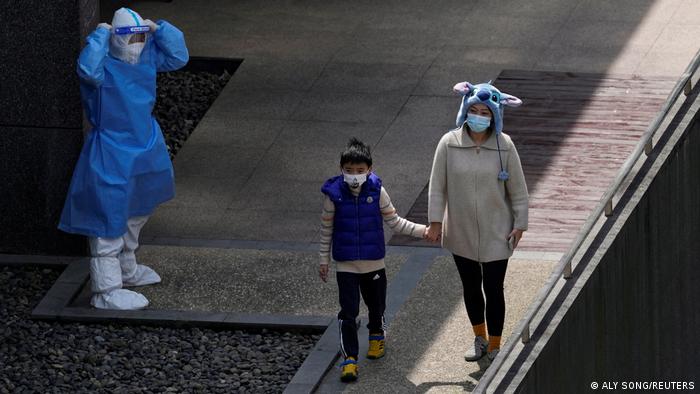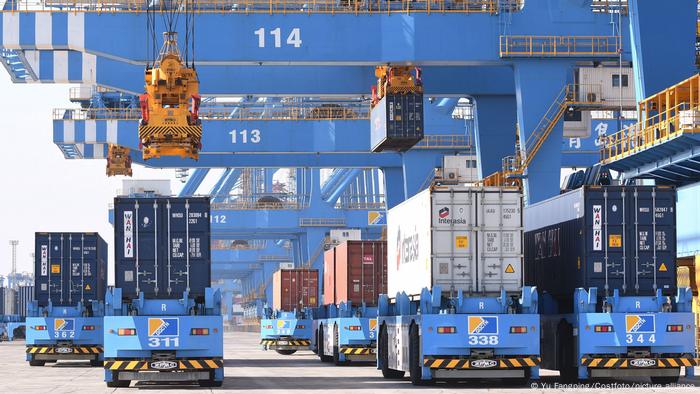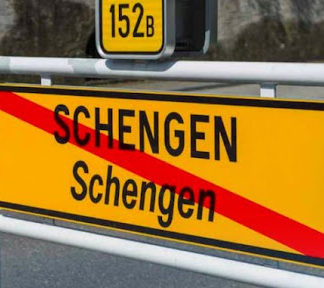Opinion: With Shanghai in lockdown, where is the light at the end of the tunnel for China?
Twenty-five million residents are currently confined to their homes in Shanghai. For residents and businesses, it is getting increasingly difficult to see a way out of the pandemic, Vincent Brussee writes.
Until spring of this year, China’s COVID-19 strategy was a remarkable success. Under its so-called dynamic clearing approach, the government is attempting to extinguish new clusters as soon as possible. This has most likely prevented millions of COVID-19 related deaths while enabling life to continue as normal in most cities.
Then came the omicron variant. At first, there was no change: megacities like Tianjin and Shenzhen all managed to curb its spread within weeks. But since March, things have looked rather different. The major outbreaks in the northeastern city of Jilin and now Shanghai have upset the country’s approach.
Shanghai’s outbreak — reporting 23,342 new cases on Tuesday, April 12 alone — is especially dramatic. The city has the most advanced health care and contact tracing systems in China and had managed to avoid lockdowns entirely since the start of the pandemic. But this success appears to have given its authorities a false sense of security and a misplaced belief that the city has some exceptional ability to evade the virus.
The wrong approach
Indeed, it looks like Shanghai’s authorities have crossed a line in their efforts to stay lockdown-free, as indications have emerged that they have been massaging their statistics for weeks. They consistently classified citizens with mild symptoms as “asymptomatic,” rather than face the consequences of skyrocketing case numbers. As the numbers of cases shot up but were not accurately reflected in the statistics, the measures announced were still only piecemeal.
But this approach has proved too little, too late and means the city is paying an even higher price now. For Shanghai’s residents, the consequences are immense. Unable to set foot outside their front door, many citizens are reporting difficulties getting food. Parents have been separated from their children in isolation wards when one or the other tested positive — a highly unpopular policy that was only corrected recently to allowing them to quarantine together. One local doctor, Zhu Weiping, claimed openly that no one listened to professionals and that the city rigged citizens’ digital health codes.
Bruising for business
Businesses, too, are feeling the impact. Compared to cities like Wuhan, Xi’an, and Changchun — all of which have been in lockdown —Shanghai is vital not only for the Chinese but also the global economy. Its lockdown has caused further shipping delays, shaking already-rattled global supply chains. European businesses in China have expressed concerns about the increasing “on-off economy.” Altogether, the lockdown is bound to dampen China’s economic development throughout the entire year.
In response, China’s central leadership has doubled down on its “dynamic clearing” strategy. Given that other cities successfully contained omicron, it appears to see Shanghai’s woes not as a failure of strategy, but a failure of implementation.
No light at the end of the tunnel
Beijing’s assessment is that the country’s health system will collapse if it gives up on its approach now. This is understandable given the country’s immense regional disparities and the still non-negligible COVID-19 pressure even in regions of the world with high levels of natural immunity. But because the government has tied its legitimacy to the success of its COVID approach, it remains extremely cautious about changes of policy. This means it can do no more than hope the next variant is milder or that a silver bullet in treatment comes along, such as a new drug or vaccine.
Shanghai will most likely overcome this current wave, just like every other city in China has. However, Shanghai’s exceptionally high case rate means the road to recovery will be longer and more arduous.
The bigger question is which city will be next, and what the way out of the deadlock will be. So far, authorities have been unwilling to allow for home quarantine of mild cases — a mandatory first step towards gradual normalization. Whether Beijing’s assessment of the situation is correct or not, it means there is no light at the end of the pandemic tunnel for many in China.
Vincent Brussee is an analyst with the Berlin-based Mercator Institute for China Studies (MERICS) where he specializes in innovative data-based approaches to study Chinese governance and society.
Edited by: Rob Mudge

































